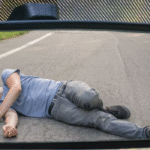Table of contents
- Types of truck accidents
- Rear-End Collisions
- Rollovers
- Drifting/Driving Off a Roadway
- Truck Tire Blowouts
- Underride & Override Accidents
- Jackknife Accidents
- Blind Spot Accidents
- Head-On Collisions
- T-Bone (Side-Impact) Collisions
- Lost Load Accidents
- Brake Failure Accidents
- Hazardous Material (Hazmat) Spills
- Multi-Vehicle Pileups
- Drowsy Driving / Fatigue Accidents
- Reckless Driving / Speeding Truck Accidents
- Distracted Driving Truck Accidents
- Wide-turn Accidents
- Protect your rights after a truck accident
A significant part of California’s economy depends on big trucks that are helpful in transporting goods across the country. However, the concern is that the size and weight of these trucks often lead to major accidents on the road. The consequences of such accidents can be devastating — and that’s where an experienced truck accident attorney can help victims recover compensation and justice.
Understanding what are the common types of truck accidents will aid in avoiding the situations and improve the chances of effectively navigating the aftermath complications.
Types of truck accidents
There are different kinds of truck accidents that you probably can come across while riding on the roads of California. Let’s see typical truck collision types here.
- Rear-End Collisions
- Rollovers
- Drifting/Driving Off a Roadway
- Tire Blowouts
- Underride & Override Accidents
- Jackknife Accidents
- Blind Spot Accidents
- Head-On Collisions
- T-Bone (Side-Impact) Collisions
- Lost Load Accidents
- Brake Failure Accidents
- Hazardous Material (Hazmat) Spills
- Multi-Vehicle Pileups
- Drowsy Driving / Fatigue Accidents
- Reckless Driving/Speeding Truck Accidents
- Distracted Driving Truck Accidents
- Wide-turn accidents
Rear-End Collisions
These kinds of collisions are very common truck accidents. Such accidents occur when a truck hits the rear side of the other vehicle. As the trucks require considerable stopping distance, these kinds of accidents will most likely happen during sudden stops or heavy traffic. Every vehicle stands closer during traffic jams. In such scenarios, moments of distraction can lead to a rear-end collision.
As per the National Highway Traffic Safety Administration (NHTSA), rear-end car accidents contribute to 29% of overall U.S. crashes.
Common causes of rear-end collisions:
- Distracted driving
- Tailgating
- Speeding
- Drunk driving
- Dangerous road conditions
- Adverse weather conditions
- Brake failures
- Defective Auto Parts
- Drowsy driving
Typical rear-end collision injuries:
Depending on the type of crash, the injuries can be minor or fatal.
- Whiplash and Neck Strain
- Back and Spinal Injuries
- Shoulder and Arm Injuries
- Back strains
- Slipped or herniated disk
- Spinal stenosis
- Spinal fractures
- Traumatic Brain Injury
- Face and Eye Injuries
- Soft Tissue Damage
- Amputations
- Burns
Types of compensation to recover after a rear-end collision
Economic damages:
- Medical expenses
- Loss of income
- Reduced earning potential
- Vehicle repair costs
Non-Economic damages:
- Emotional distress
- Reduced quality of life
- Loss of enjoyment
Punitive Damages (in rare cases)
If the at-fault driver is found to be reckless or acted negligently, the court will award punitive damages.
Rollovers
Rollover accidents are among the deadliest truck accidents. These accidents happen when a truck tips over its roof or on its side. As such incidents can involve multiple vehicles, the consequences are very serious. If the load of the truck shifts suddenly, the center of gravity of the truck collapses, leading to instability of the truck.
What causes a rollover?
According to the FMCSA, over 80% of truck rollovers occur due to the driver’s error. Other common causes include:
- Overloading or Improper Loading
- Lack of training
- Maintenance negligence
- Reckless Maneuvers
- Speeding
- Mechanical Failures
- High Center of Gravity
- Poor weather conditions
- Road conditions and designs
Truck rollovers cause major injuries
When a truck rollover happens, the victims of the accident are at major risk of severe injuries or even death. Since the heavy load of the truck can translate into a huge force, the smaller vehicle will have serious damage.
Some of the major injuries due to rollovers are:
- Head and brain injuries
- Neck injuries
- Spinal cord injuries
- Amputations
- Back injuries
- Burns
- Fatal injuries
- Broken bones and fractures
Who is held liable for a truck rollover?
Determining the liability for the truck rollover is a complex task. Based on the situation, there could be more than one person liable for the collision. Hiring a skilled attorney helps in identifying the underlying cause of the collision, and they will find out the potentially liable parties for the accident.
Drifting/Driving Off a Roadway
When a commercial truck or semi-truck unexpectedly leaves the road and deviates from its lane, it puts everyone into a dangerous situation. As the trucks will be moving on a multi-lane road (interstate pathway), drifting or driving off the roadway will also force other drivers off the road.
Common causes of drifting or driving off the road truck accidents
- Driver fatigue
- Distracted driving
- Speeding or losing control on curves
- Uneven loading
- Mechanical failures
- Poor weather or road conditions
- Exceeding weight capacity
- Traffic violations
Your legal course of action after a drifting or driving off the road truck accident
- After the truck accident, you should contact the emergency helpline first
- You have to get medical attention as soon as possible, even if you don’t have any visible injuries
- Collect and preserve evidence of the accident scene and other injuries, and damages
- Avoid speaking with insurance adjusters or others
- Contact a truck accident attorney to handle legal complications
Truck Tire Blowouts
Large trucks typically have 18 wheels and are paired side-by-side. If any of these wheels blow out on the road, the truck will lose its control and can rollover or swerve into another lane.
A truck tire blowout can happen in a fraction of a second and may lead to severe injuries and fatalities. The explosion of the truck’s tire can tip the vehicle off balance. Even a skilled driver may lose control of the vehicle.
Common causes of truck tire blowouts:
- Improper tire maintenance
- Excessive load weight
- Manufacturing defects
- Underinflated/ overinflated tires
- Road hazards
- Wear and tear
What causes the accident after a truck tire blowout?
There are several aspects that may lead to an 18-wheeler collision. These cover:
- Loss of control over the truck
- Flying tire debris can hit the vehicle
- Sudden braking or erratic maneuvers increase the risk of an accident
- Improperly secured cargo may get loose during a tire blowout, and the sudden shift can lead to an accident.
Underride & Override Accidents
Underride accidents happen when smaller vehicles slide under the side or rear of the large trucks.
Cause of underride accidents:
When a truck suddenly stops, and a smaller car that follows the truck can’t prevent sliding under the truck
- Poor visibility
- If the truck changes lanes or turns without an adequate signal
- A lack of reflective tape
An override accident can occur if the truck’s front end on the roadway crashes into the back side of a passenger car.
Common causes of override accidents:
- Speeding or aggressive driving
- Truck drivers driving too close behind passenger cars
- Fatigue
- Distracted driving
- Brake failure
Jackknife Accidents
When looking at the most common truck accident types, the next comes the jackknife accidents. These accidents happen when the back of the trailer of the truck swings forward and creates a sharp ‘V’ shape, and the driver loses control over the truck and causing an accident.
When the truck swings extensively into a jackknife position, it bangs drastically into other vehicles. During truck jackknifes, there is a possibility for multi-vehicle collisions.
What Causes a Jackknife Accident?
Human errors:
- Rash driving around the downhill or curves
- Sudden hard braking or maneuvers
- Driver fatigue
- Lack of driver training
Mechanical issues:
- Fault brakes
- Worn tires
- Improper or unbalanced cargo
Weather conditions:
- Rain, snow, or strong winds
- Slippery roads
- Icy roads
- Poor visibility in fog
Why are jackknife accidents very dangerous?
As these accidents occur on the roadways and can happen quickly and without any warning signals, they are hazardous to other vehicles, too.
- The loss of control of a driver can put the other lives on the road at risk.
- Can end up in multi-vehicle collisions
- If the wheel of the truck loses traction, it will flip over, resulting in traffic congestion and serious property damage.
“Jackknife” truck accident example
A snowfall leads to a slippery road surface. If a semi-truck driver loses vehicle control and tries to make an abrupt brake, it leads to a jackknife accident.
Blind Spot Accidents
Trucks have certain blind spots, which are the typical areas where the driver can’t see other vehicles. These areas are called no-zones. Vehicles caught in such areas can be sideswiped if the truck collides or changes lanes without seeing those vehicles.
The risk of blind spot accidents is higher among semi-truck accident types, as the trucks have many larger blind spots.
Where are the blind spots of a truck?
- Front blind spot – at least 20 feet in front of the cabin
- Rear blind spot – extends up to 200 feet behind the truck trailer
- Left blind spot – One lane of traffic to the truck’s left side
- Right blind spot – two strips on the truck’s right side and covers backwards
Ways to Avoid Blind Spots around 18-Wheelers
- Keep a safe travelling distance behind the truck
- Don’t take too much travel time in the blind spot. Pass quickly in a safe manner.
- If you are changing lanes, give early warning signs
- Be cautious at intersections
- Avoid changing lanes closely behind or in front of the large commercial truck.
Head-On Collisions
When you are thinking about ‘what are the common types of truck accidents’, here comes the head-on collisions that occur when a truck swings into oncoming traffic. If the truck crashes head-on with the other vehicle on the road, it will lead to severe consequences.
Head-on crashes are destructive since these accidents combine the force of both vehicles. Head-on collisions contribute significantly to fatal truck accidents each year.
Some common causes leading to head-on truck collisions:
- Speeding
- Violating traffic rules
- Distracted driving
- Intoxication
- Drowsy driving
- Poor truck maintenance
- Impaired driving
California Laws That Govern Head-On Collisions
Negligence law:
California adheres to pure comparative negligence, which means that if the victim is found to be partially at fault, they can still recover damages. However, the percentage can be reduced by the level of fault.
Right-of-way rules:
According to the Vehicle Code Section 21650 of California, the driver violating the rule is liable for a collision.
Distracted driving law:
Drivers should avoid using handheld electronic devices. If it is found to be used, it is evidence of negligence.
Impaired driving law:
Drunk drivers are accountable for collisions.
T-Bone (Side-Impact) Collisions
A T-Bone collision, also called a side-impact collision, can happen if the truck collides into the side of another car, most likely at intersections. In such accidents, the passengers on the other side of the vehicle are exposed to serious injuries. Since the immense weight of trucks takes time to stop, large commercial trucks often lead to T-bone collisions.
Common scenarios leading to T-bone collisions
- Running red lights /stop signs
- Unsafe left-hand turns
- Braking errors
- Distracted driving
- Failure to yield
- Excessive speed
- Aggressive driving
- Driving under the influence
Either driver in the accident can be at fault
If one of the two drivers doesn’t ensure the right of way to the other vehicle, a T-bone collision can occur. Determining fault in these accidents needs evidence, police reports and witnesses.
Lost Load Accidents
Lost Load Accidents happen when the cargo falls off the truck due to not being secured properly or being overloaded. In rare cases, the cargo can collide with another vehicle when it falls from the truck. Based on the type of cargo, the severity of consequences can vary.
A CHP report says that more than 50,000 overweight violations occur across the commercial vehicle inspection stations of California.
Commercial trucks can weigh up to 80,000 pounds. The cargo of such vehicles must be properly loaded and secured to avoid falling out or shifting from the truck.
Legal Weight Limits and Guidelines
In California, as per the vehicle code section 35551-35796, the maximum gross weight allowed for trucks is 80,000 pounds.
Core limitations cover:
- The maximum gross weight of the vehicle should be 80,000 pounds
- Single axle: 20,000 pounds
- Tandem axles: 34,000 pounds
- For weight distribution across axles, the bridge formula is applicable
Brake Failure Accidents
Commercial truck brakes should be maintained to the highest safety standards. They have to be constantly checked and replaced to avoid any mishaps. Fully loaded trucks typically can weigh up to 80,000 pounds. If brakes don’t function properly, the stopping distance will be increased. This extra time and distance can often lead to catastrophic injuries to other drivers and passengers if the truck results in chain-reaction collisions.
How defective brakes cause an accident?
As the commercial trucks are big and weigh heavily, their brakes should be in top-notch condition. Generally, trucks need more time to stop. During the malfunctioning of brakes, the stopping distance is increased and leading to runaway truck collisions.
Some common large truck brake failures:
- Worn brake pads
- Overheating due to prolonged use
- Brake fluid leakage
- Malfunctioning of air brake systems
- Poor brake installation
- insufficient brake maintenance
How to determine that brake failure caused the accident?
Signs such as long skid marks, smoke or burn odors or inspection records that reveal the effect of defective or worn parts help in understanding that the cause of the accident is brake failure. In most cases, the truck accident lawyer will use an accident reconstruction specialist to confirm that the brake issues have resulted in the accident.
Hazardous Material (Hazmat) Spills
If the cargo containing hazardous material (HAZMAT) spills is improperly secured or loaded, it will lead to serious consequences. Even if the truck doesn’t tip, however, if the cargo has fallen, the spillage can create dramatic hazards to others on the road.
Across California, out of the common commercial truck accident types, cargo spills contribute to 20% of the accidents. When trucks carrying hazardous materials are involved in a collision, they can release harmful chemicals that pose a threat to the lives of people.
Some toxic chemicals in Hazardous Material (Hazmat) spills include:
- Diesel Exhaust and Fuel Spills
- Hazardous materials
- Industrial chemicals
- Petroleum products
- Radioactive materials
Potential Health and Environmental Impacts
- Breathing problems
- Chemical burns to the eyes and skin
- Stomach upset and vomiting
- Head pain
- Long-term impacts such as cancer, infertility, brain & nerve disorders and harm to the liver and kidneys
- Environmental impacts include contaminated soil and water resources
Multi-Vehicle Pileups
There are thousands of commercial trucks and cars speeding along the lanes of the busiest highways in California. When looking into the question of what are the common types of truck accidents are, multi-vehicle pileups and chain reaction crashes are devastating incidents. As these accidents involve various vehicles, leading to extensive disruption, the consequences are serious injuries and fatalities.
What are multi-vehicle pileups?
These are the collisions where three or more vehicles are involved in a sequence of effects. These accidents generally start when a collision occurs between two vehicles, and the resulting force leads to a growing accident scenario.
Causes for multi-vehicle pileups
- Bad weather conditions such as ice, fog and rain
- High-speed
- Distractive driving
- Sudden stops
- Driver errors
- Overloaded or poorly secured cargo
Consequences after a multi-vehicle pileup
If a commercial truck is involved in a multi-vehicle pileup, the situation becomes worse. The consequences can be severe that affecting families, victims and communities.
- Minor to major injuries
- Fatalities
- Traffic delays for hours
- Serious vehicle damage
Drowsy Driving / Fatigue Accidents
Fatigue of the truck driver impacts the ability to promptly respond and having the grip of the vehicle. The huge commercial trucks mean even a minor lapse can end up in a devastating situation. If the driver is fatigued and loses control, the chances of fatal collisions increase.
The unrealistic deadlines set by the truck companies pressure the drivers to drive beyond safe limits. Beyond the actual 11hours of time, the drivers are pushed to drive for up to 14 hours. This leads to the risk of drowsy driving accidents.
What leads to the fatigue of truck drivers?
- Prolonged hours behind the wheel
- Monotonous driving
- Undiagnosed sleeping disorders
- Sleep deprivation
- Medications
Consequences of drowsiness during driving
- Multi-Vehicle Crashes
- Serious or fatal injuries
- Property damage or economic losses
Who is liable for fatigue accidents?
Potentially liable parties for fatigue accidents include:
The truck driver – Neglecting rest hours, false logbooks or driving in drowsiness
The truck company – the truck companies pressure drivers to operate beyond safe limits
Third parties – vehicle maintenance providers or dispatchers can be liable if they encourage unsafe driving.
Reckless Driving/Speeding Truck Accidents
Reckless driving remains a major cause of the common big rig accident types in California. If the truck driver operates the vehicle aggressively or recklessly, it increases the risk to the lives of others on the road. If a tragic accident occurs, the driver is liable for the injuries and damages.
What’s reckless driving?
According to the California Vehicle Code § 23103(a), the following actions are considered reckless driving:
- A driver operating a vehicle on a highway willfully or purposefully leading to the unsafety of people or property
- Those who drive in an off-street parking facility, intentionally harming people or property, are considered reckless drivers
Common behaviours of reckless driving:
- Excessive speeding
- Racing other cars
- Not yielding the right way
- Weaving in and out of lanes
- Brake checking
- Running red lights/stop signs
- Not obeying the rules
- Impaired driving
Distracted Driving Truck Accidents
Truck accidents are sad incidents leading to devastating consequences. Distracted driving, among the major types of truck crashes, claimed over 3000 lives in 2020 in the United States. Distracted driving is straightforward. The truck driver was not paying attention to the road and has led to the crash that might result in serious injuries.
Legal negligence typically has 4 aspects:
- Duty
- Causation
- Breach of duty
- Damages
Common distracted driving types:
- Texting or using a mobile phone
- Adjusting controls
- Eating or drinking
- Talking to passengers
- Fatigue
- Grooming
- Reaching for objects
- Talking on the phone
Ways to prevent distracted driving:
- Limit distractions inside the vehicle
- Operate the vehicle only when you are alert
- Prevent external distractions
- Avoid activities like eating, drinking or grooming
Wide-turn accidents
Improper turns have resulted in the loss of the lives of 31 people, and 546 people were injured in 2012 in California. Operating a commercial truck requires cautious driving and training skills. While making turns, the truck driver if fail to take proper precautions, which can injure the pedestrians.
Examples of errors a driver makes while making turns:
- Swinging out excessively to the left
- Not giving a signal before making a turn
- Turning from the wrong lane
- Impaired driving
- Not waiting for the traffic to clear
Who is liable?
There can be a number of potential parties for this truck accident, which include the truck driver, the truck company, the loading company and the manufacturing company.
Protect your rights after a truck accident
Hope you have a comprehensive understanding about what are the common types of truck accidents. If you have suffered from any of these truck accidents, you have to protect your rights. Investigating these accidents is complex and requires legal expertise. Hiring a truck accident lawyer helps to claim compensation, which is essential for recovering physical health and financial stability.




